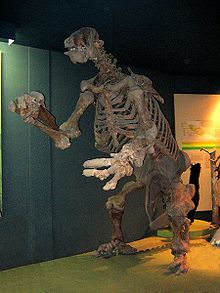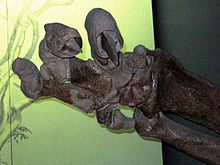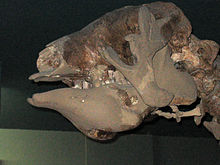- Megatheriidae
-
Megatheriidae
Temporal range: 35–0 Ma Early Oligocene to Recent
Eremotherium skeleton, NMNH, Washington, DC. Scientific classification 
Kingdom: Animalia Phylum: Chordata Class: Mammalia Order: Pilosa Suborder: Folivora Family: †Megatheriidae
J. E. Gray, 1821Subfamilies see text
Megatheriidae is a family of extinct ground sloths that lived from approximately 23 mya—11,000 years ago, existing for approximately 22.89 million years.[1]
Megatheriids appeared later in the Oligocene, some 30 million years ago, also in South America. The group includes the heavily-built Megatherium (given its name 'great beast' by Georges Cuvier[2]) and Eremotherium. Other megatheriids, such as the more slightly built nothrotheres Hapalops and Nothrotheriops, reached a length of about 1.2 meters. The nothrotheres have recently been placed in their own family, Nothrotheriidae.[3]
The skeletal structure of these ground sloths indicates that the animals were massive. Their thick bones and even thicker joints (especially those on the hind legs) gave their appendages tremendous power that, combined with their size and fearsome claws, provided a formidable defense against predators.
The earliest megatheriid in North America was Eremotherium eomigrans which arrived 2.2 million years ago, after crossing the recently formed Panamanian land bridge. With more than five tons in weight, 6 meters in length, and able to reach as high as 17 feet (5.2 m), it was taller than an African Bush Elephant bull. Unlike relatives, this species retained a plesiomorphic extra claw. While other species of Eremotherium had four fingers with only two or three claws, E. eomigrans had five fingers, four of them with claws up to nearly a foot long.[4]
The last ground sloths in North America belonging to Nothrotheriops died so recently that their petrified dung (coprolites) has remained undisturbed in some caves, as if it were just recently deposited. One of the skeletons, found in a lava tube (cave) at Aden Crater, adjacent to Kilbourne Hole, New Mexico, still had skin and hair preserved, and is now at the Yale Peabody Museum. The American Museum of Natural History in New York City has a sample of dung with a note attached to it that reads "deposited by Theodore Roosevelt". The largest samples of Nothrotheriops dung can be found in the collections of the Smithsonian Museum.
FAMILY †MEGATHERIIDAE Gray, 1821
- Subfamily †Megatheriinae
- Tribe †Megatheriini
- Subtribe †Prepotheriina
- Genus †Proprepotherium
- Genus †Planops
- Genus †Prepotherium
- Subtribe †Megatheriina
- Genus †Megathericulus
- Genus †Promegatherium
- Genus †Plesiomegatherium
- Genus †Megatheridium
- Genus †Pyramiodontherium
- Genus †Megatherium
- Genus †Eremotherium
- Genus †Ocnopus
- Genus †Perezfontanatherium
- Subtribe †Prepotheriina
- Tribe †Nothrotheriini
- Genus †Pronothrotherium
- Genus †Xyophorus
- Genus †Chasicobradys
- Genus †Gilsolaresia
- Genus †Diheterocnus
- Genus †Synhapalops
- Genus †Nothropus
- Genus †Thalassocnus
- Genus †Nothrotherium
- Genus †Nothrotheriops
- Tribe †Megatheriini
- Subfamily †Schismotheriinae
- Genus †Hapaloides
- Genus †Schismotherium
- Genus †Hapalops
- Genus †Pelecyodon
- Genus †Parapelecyodon
- Genus †Analcimorphus
- Genus †Hyperleptus
- Genus †Neohapalops
References
- ^ http://paleodb.org/cgi-bin/bridge.pl?action=checkTaxonInfo&taxon_no=43608&is_real_user=1 :Paleobiology Database: Megatheriidae
- ^ G. Cuvier (1796)
- ^ Muizon, C. de; McDonald, H. G.; Salas, R.; Urbina, M. (June 2004). "The Youngest Species of the Aquatic Sloth Thalassocnus and a Reassessment of the Relationships of the Nothrothere Sloths (Mammalia: Xenarthra)". Journal of Vertebrate Paleontology (Society of Vertebrate Paleontology) 24 (2): 387–397. doi:10.1671/2429a. http://www.bioone.org/doi/abs/10.1671/2429a. Retrieved 2009-01-29.
- ^ De Iuliis and Cartelle (1999)
External links
Categories:- Prehistoric sloths
- Subfamily †Megatheriinae
Wikimedia Foundation. 2010.


